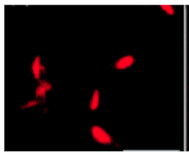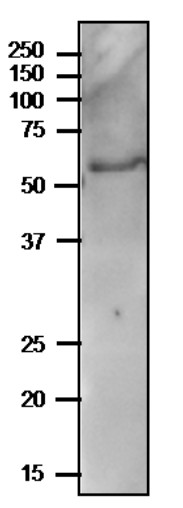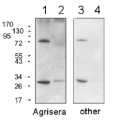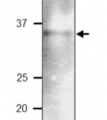1

Anti-PYK10 | Beta-Galactosidase (internal) (ER marker, immunolocalisation)
- Product Info
-
Immunogen: Conjugated peptide, derived from Arabidopsis thaliana internal part of PYK10, UniProt: A0A178VCN3, TAIR: At3g08880. Host: Rabbit Clonality: Polyclonal Purity: Total IgG. Protein A purified in PBS, 50% glycerol. Filter sterilized. Format: Liquid at 2 mg/ml. Quantity: 100 µg Storage: Store at -20°C; once reconstituted make aliquots to avoid repeated freeze-thaw cycles. Please remember to spin the tubes briefly prior to opening them to avoid any losses that might occur from material adhering to the cap or sides of the tube. Tested applications: Immunofluorescence (IF), Immunohistochemistry (IHC), Immunoprecipitation (IP), Western blot (WB) Recommended dilution: 1: 100 -1: 500 (IF), 1: 500 (IHC), 1: 500 (IP), 1: 5000 - 1: 20 000 (WB) Expected | apparent MW: 59.7 kDa - Reactivity
-
Confirmed reactivity: Arabidopsis thaliana Predicted reactivity: Brassica napus, Brassica oleracea
Species of your interest not listed? Contact usNot reactive in: Triticum aestivum - Application Examples
-

Arabidopsis thaliana 7 day-old seedlings was freshly extracted with 2x SDS-sample buffer (+ 2ME) for SDS-PAGE and denatured with 4X SDS buffer at 95°C for 5 min. were separated on 12.5 % SDS-PAGE and blotted to PVDF membrane in semi-dry system. Blot was blocked with 5 % skim milk/TBS-T, 1h/RT with agitation. Blot was incubated in the primary antibody at a dilution of 1: 5000 in TBS-T for 1h/RT. The antibody solution was decanted and the blot was washed 4 times for 10 min in TBS-T at RT with agitation. Blot was incubated in matching secondary antibody (anti-rabbit IgG horse radish peroxidase conjugated) diluted to 1:10 000 in for 1h/RT with agitation. The blot was washed as above and developed with a chemiluminescent detection reagent, following manufacture's recommendations.
Left panel: anti-PYK10 antibodies, middle panel: GFP, right panel: marged
The P1 pellet was obtained from 8 day-old seedlings (carrying GFP gene with ER-retension signal). Anti-PYK10 antibodies: 1: 500, secondary antibodies: goat anti-rabbit IgG Alexa Fluor546 at 1: 1000.
PYK10 is localising to ER bodies, - Additional Information
-
Additional information (application): N-terminal signal peptide including 24 amino acis and ER retention signal is removed from the mature protein - Background
-
Background: PYK10 is the main component of ER bodies. It has hydrolase activity, hydrolyzing O-glycosyl compounds It may produce defense compounds when plants are damaged by insects or wounding. - Product Citations
-
Selected references: Yamada et al. (2013). Identification of Two Novel Endoplasmic Reticulum Body-Specific Integral Membrane Proteins. Plant Physiol. 2013 Jan;161(1):108-20. doi: 10.1104/pp.112.207654. (Western blot, Arabidopsis thaliana)
Nagano et al. (2005). Activation of an ER-body-localized ß-Glucosidase via a Cytosolic Binding Partner in Damaged Tissues of Arabidopsis thaliana. Plant Cell Physiol. 2005 Jul;46(7):1140-8. doi: 10.1093/pcp/pci126. (Immunoprecipiation, Western blot, Arabidopsis thaliana)
Matshushima et al. (2003). A novel ER-derived compartment, the ER body, selectively accumulates a beta-glucosidase with an ER-retention signal in Arabidopsis. Plant J . 2003 Feb;33(3):493-502. doi: 10.1046/j.1365-313x.2003.01636.x. Immunofluorescence, Immunohistochemistry, Western blot, Arabidopsis thaliana) - Protocols
-
Agrisera Western Blot protocol and video tutorials
Protocols to work with plant and algal protein extracts
Agrisera Educational Posters Collection
- Reviews:
-
This product doesn't have any reviews.



